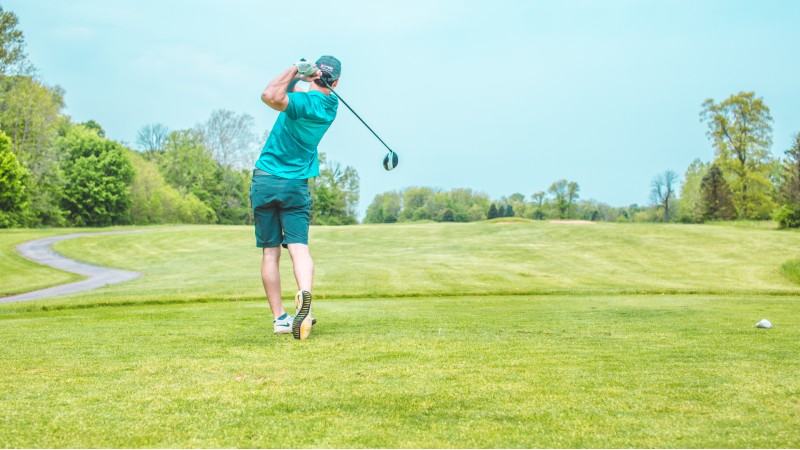You reach the first par 3 on your local course and you want to hit the green and get a putt for birdie. You check the yardage and you check the wind. You notice the hole is playing slightly downhill. Looking for as much information as possible, you ask your playing partner, “what club are you hitting”. He responds, “I am going to hit 8-iron”.
You decide you need to hit 6-iron to have any chance of reaching the green. Are you really short or is your friend really long? Do your clubs not go as far as they should? Is there a problem with your equipment or your swing technique?
So that leads us into golf club distances; how far should you reasonably expect to hit your clubs and does how far you can hit a golf ball have a direct impact on your score?
Well, it could, but never forget consistency probably plays a bigger role in your current handicap. Let’s look closer.
You may also enjoy
- https://clubandtee.com/how-long-does-it-take-to-play-a-round-of-golf/Shafts explained: What is the best shaft flex for a beginner golfer?
- What Is A Good Handicap For A Beginner? | Handicap FAQs
- Are Portable Launch Monitors Worth It? – All You Need To Know
- How Long Does Golfing Take To Play A Round Of Golf?
- What are the Odds of Becoming a Professional Golfer?
How far should I hit a 7-iron?
Tiger’s caddie, Joe LaCava, would tell you that Tiger hits his 7-iron 170 yards on average, but that probably isn’t the best measuring stick for amateur players.
Irons are designed to have a difference in yardage of ~10 yards for most players. In other words, if you hit your 5-iron 170 yards, you probably hit your 6-iron ~160. There will be variance amongst players of the same handicap due to type of club and swing speed, but a 7-iron going 140 yards is typical for the average player.
With that number in mind, you can figure that the average 8-iron would be 130, 6-iron would be 150, etc. The driver and woods will be different.
Driver distance varies the most from golfer to golfer. Age and handicap play a significant role in how far it travels. For the average player, a straight drive may go 225 yards. A 3-wood, closer to 200 yards.

How far should a beginner golfer hit the ball?
To answer this question, we need to consider the factors that lead to distance. The key ones are swing speed and consistency of the strike (hitting the ball solid). Just because you are a beginner doesn’t mean you won’t have swing speed. You may swing the club very fast the first time you try.
The challenge for a beginner will be hitting the ball consistently. You may crush 1 out of 10, but the other 9 may not travel very far at all (hopefully, no whiffs). In other words, a beginner won’t necessarily be shorter than a more experienced player, but the beginner’s variance will be much larger.
A player trying golf for the first time is very likely to hit a 7-iron 140 yards, but will it be on target and can they do it more than once?
Probably not.
If you are a beginner trying to gauge distance, you may want to factor in the probability of hitting it perfect. If your perfect 7-iron goes 140 yards, you may want to hit it on the course from 130-135 yards, allowing for a bit of an off-center strike.
Does distance really matter? Is longer, better?
Most golfers become infatuated with distance. How many times in a casual golf conversation have you been asked, “How far do you hit your driver”? How much does distance really matter? Will a player who hits his driver 225 yards and hits every fairway beat a player who hits it 300 yards, but is constantly in trouble (woods, bunkers, OB)? The straight player wins every day and twice on Sunday!
With that being said, where does distance impact your scorecard? Within reason, the distance you hit your irons doesn’t really matter – consistency is the key. If you have to hit 5-iron from 150-yards, but you can consistently hit the green, it doesn’t matter if you opponent is hitting 7-iron. With your irons, don’t worry about how far, worry about how straight.
What about your driver? There is no doubt that distance off the tee is an advantage. You need to be able to keep it in play but being longer means shorter shots to par 4s and potentially reaching par 5s in two. This will impact your score and your handicap.
The good news is that the modern driver is probably the easiest club to hit in your bag. The head is gigantic, the sweet spot is large, and you get to place it on a tee. Your driver swing is the one time you should give it 100% – all your power.

A simple drill to add some speed
If you still struggle to get distance off the tee, try a quick drill. Do you have an aiming stick? If not, use one of your irons, but hold it by the head. Now take a swing, swinging as hard as you can.
Where do you hear the “whoosh” sound? Many beginners and high handicappers will hear the sound at the top of their swing or prior to the impact position. This means their maximum power is being wasted before they reach the golf ball. Obviously, you would like your maximum speed to be at impact.
The goal of this drill is to hear the “whoosh” at the bottom of your swing or even just past impact position. Once you hear it there, hit some drivers. This should help you gain some yardage.
Final thoughts on golf club distances
How far you hit your clubs will depend on several factors. Age, skill, technique, flexibility, and strength, to name a few, but the key is knowing how far you hit your clubs. If you have ever listened to a PGA tour pro discuss club selection, they know how far they hit each club down to the yard. Do you know your distances that well? The next time you visit the driving range try to make a chart of yardage for each club in your bag.
As you play more golf, you will gain distance. You will start hitting the ball more solidly on a more consistent basis and this will give you some additional yardage.
You don’t have to be long to be good at golf – you can be an elite player with below average distance. Consistency is the attribute that truly separates players.


This may be true for younger players and more experienced players but as we get older those number may not be accurate.
I agree
Distance at the range will be different than true distance on the course.
This was so helpful,I always say that we as golfers are tricked by the size of the driver head thinking how can we miss,so we just bomb away,thanks for the info very on point
I out drive JD one day,
I hit a 5 iron off Mout Nebo in ARKANSAS. IT went up and out about 200 yards then dropped for about a thousand yards. A bet is a bet… he paid
Very informative article. I been one who always try to hit with the big boys, but as you stated consistency is the keys.
Best advice play a set of tees that suit your game and ability. Too many play the wrong distance because of the assumption red is for women, white and blue are for men. No longer the case. Tees are gender neutral.
Absolutely true. The tee boxes aren’t determined by your gender, but by your handicap.
I’m 69 years old. 7 iron is about 145 yards. Driver is 220. The main thing is to swing smooth. The minute you try to swing hard is when you make poor contact and the top speed of your club isn’t at contact.
I would rather hit it 200 in the middle of the fairway than 220 in the left or right rough. Just make sure you have a club for every distance.
Still waiting for information the headline implies will be in the column. To wit: how far we should be hitting our clubs.
I was expecting information based on golfers’ age, health, handicap, etc. Instead, there’s nothing dispositive in this column. The reference to “the average golfer” is useless. Who is “the average golfer”? Is it the average of ALL golfers?
And the part about how far beginners should hit their clubs is of no use to beginners or to regular golfers.
Not trying to be an ahole or anything. It’s just that this column doesn’t tell us anything helpful or useful about “how far we should be hitting our clubs”.
That’s a good idea, I’ll look to expand and add that in a future update.
Never was a good golfer, but the game is still fun…having reached retirement age I scooted up to the geezer tees and never looked back…and like many geezers my distance has suffered tremendously, and even worse when certain aches and pains come along for the round…it’s okay, I only have to beat brother and brother-in-law to have a great day…
Haha, you’re right, you don’t have to play well, just better than the person next to you! Just relax and enjoy whatever tee you can, that’s the best attitude.